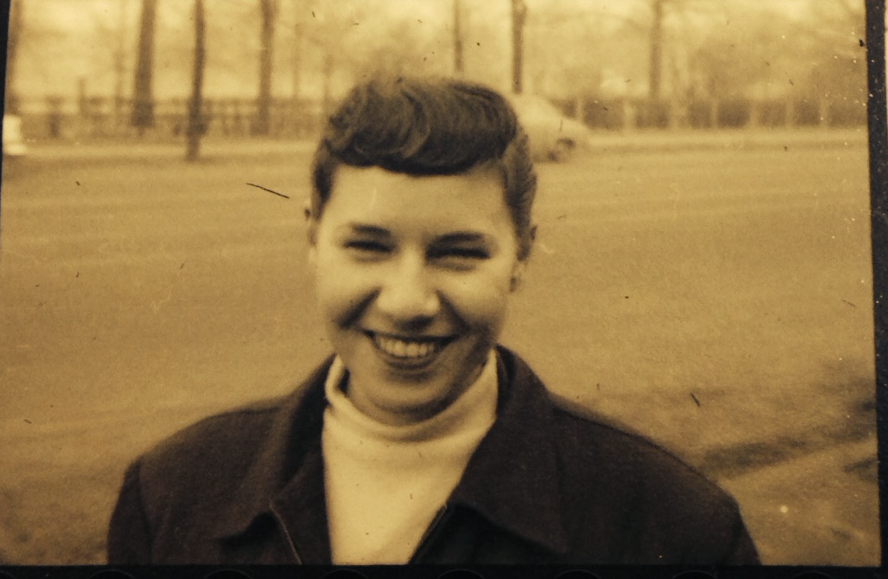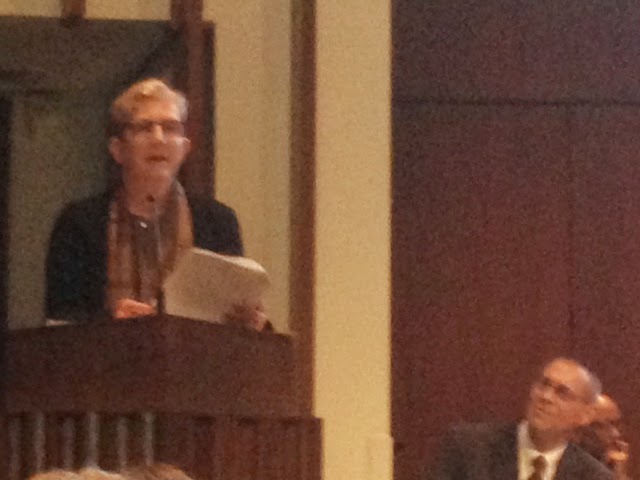Remembrance of my Mother
“All real living is meeting”
Mark Auslander
June 25, 2014
(Read at Ruth Auslander's Memorial Service)
Going through my mother’s papers a few days after her death, I came across an essay on the great Jewish philosopher Martin Buber. Ruth had circled a passage from
I and Thou:
“All real living is meeting.” For Buber, “meeting” is not simply a matter of going through a conventional script of polite exchanges. It is, rather, the dedicated pursuit of dialogue, grounded in the commitment that all knowledge emerges through our dynamic relationships to persons and things outside of oneself. A real encounter, a transformative meeting with the Other is thus the most central imperative of our lives as human beings.
This afternoon, I find myself thinking of some of striking moments of “meeting” in my mother’s life, in Buber’s sense of the term.
She often told the story of standing on the street, one night, with my father Joe in the early years of their marriage, gazing up at their apartment as firefighters fought a blaze in an adjacent unit. Joe said to her, “If this was a war, we wouldn’t even be safe on the street.” At that moment, she said, she was filled with a sense of love for all those, everywhere, suffering the loss of home. My mother’s story of that “meeting” was characteristic of her: a reminder that one’s own suffering should never be an excuse for self-pity but rather occasion a greater sense of compassion for others. In Buber’s sense, these are meetings, occasions of “real living,” that take one beyond the conventional confines of the self, even as they help us discover the self.
Other transformative meetings followed her divorce, when she decided to pursue, full time, her education to become a nurse. She started attending Georgetown University, at age 47. Simultaneously, she began work in the National Institutes of Health, during the mounting AIDS pandemic. Ruth, like many of her fellow nurses, quietly reached out to the families of the dying, to arrange for final meetings of reconciliation. She would describe poignant late night meetings with mothers who were clutching only a letter, seeking a dying son, pleading that Ruth would not let their husbands know that they had come. Ruth told me that she felt this was the most important work she had ever done, helping those mothers find the courage to come up to the ward and embrace their sons, before their end, acknowledging and accepting them as gay men.
A child of the New Deal, who came of age in the shadow of the Great Depression and the Holocaust, Ruth’s politics were deeply personal, born of her love of individual human beings rather than abstract ideological principles. In Women’s Strike for Peace, the anti-vietnam war movement, or her later political and ethical engagements, she took her greatest joy in friendship with those who shared her passion for peace and social justice.
Mom also had the gift of knowing how to end a meeting. I remember the moment in October 1987, as I was just about to return to Mtizwa village in Eastern Zambia to complete my doctoral research. Months earlier, I had been medically evacuated out of the country with cerebral malaria, and nearly died. Now, I was physically ready to go back, but terrified of doing so, even though, as my mother well knew, I wanted more than anything in the world to return to Mtizwa and pursue my career as a cultural anthropologist. Ruth was herself consumed by worry over my health in Zambia. That moment standing by the airport shuttle van, I was about to prevaricate over leaving, willing to be convinced to do an historical project and never go back into the field. Without warning, Mom suddenly reached out, hugged me, and said proudly, “This time, I know its going to be wonderful.” And then she quickly turned and walked back into her building. That remembrance-- of her complete, unconditional faith in me and her certain knowledge I would exceed my expectations of myself--sustained me during the hard months ahead back in Africa. It sustains me now.
Then, there were other partings, other endings. After her diagnosis with lung cancer, three years ago, she was tireless in her quest for treatment. She enrolled herself in a promising clinical trial at Sloan Kettering. Once or twice a week she took the Vamoose bus up to New York City, for treatment and tests. She took great pride in doing these trips on her own, and often returned energized with stories of the fascinating people she had met along the way. She knew, she explained, that she had tried everything.
“All real living is meeting.” This principle infused, in a manner that continues to astound us, her final day of consciousness. Two weeks ago to the day, my mother awoke, after a difficult, painful night, in her Hospice room, with full clarity of mind. She proceeded, when confronted with difficult medical choices, to choose a pathway that would suspend treatment and allow her to end her suffering while maintaining her dignity. She then drew up a list of many people, nearly all of them women, she wanted to speak to by telephone to make her farewells. Each conversation was different, but each was full of compassion, concern, and grace. We must, she told each person, hold on to what we have shared together, which has been so full and beautiful. To the last, she comforted each of her interlocutors. That evening, she presided over an impromptu dinner party in the hospice’s common room, of Burmese take-out. Characteristically, she insisted for this event on getting out of her wheelchair and sitting in a proper seat, at the head of the table--concerned for everyone’s welfare, taking pleasure in the free-ranging conversation.
Around 4:30 a.m. that morning she slipped into what would be her final sleep, about 28 hours in a “non-responsive state.” We will never know what she was conscious of during this period of rest, as she breathed steadily, sixteen times a minute. She was surrounded throughout this time by family and friends. The grandchildren played a beautiful violin concert; we shared family memories as we looked through old photograph albums; Bonnie played for her a haunting compilation on the recorder of all the songs she had sung to us as children. I noticed again and again that however the nurses rearranged her on the bed, Ruth would return to a characteristic gesture, her right hand resting lightly over her left forearm. She was, we all felt sure, still present
Friday morning, it was raining heavily, and I was alone with Ruth by her bedside. I was holding her hand as her steady, quiet breaths continued. The rain stopped and the clouds parted. “Look, Mom,” I said, “The sun has come out.” I heard two softer, quieter breaths. And then all stopped. I gazed at her face, bathed in the sudden, unexpected sunlight. Her mouth was slightly open, as if she was about to say something, suspended in mid-thought. I like to think she was in the midst of yet another meeting, a new encounter, the very stuff which all real life is made of.
Yet, that is not the moment I will hold most clearly of my mother. Rather, in my mind’s eye I see her recounting, so many times, her very favorite joke. A story, appropriately, about a meeting.
This is the joke, she would always explain, with which her dear friend Amy Kleppner invariably started her Introduction to Philosophy course:
A nervous young man, about to go out on his first date, anxiously asks a more experienced friend for guidance. There are three conversation topics that can’t fail on a date, he is counseled; food, family, and philosophy.
So at dinner with the young woman, he carefully consults his list: Food.
He asks her, “Do you like
lokshen?” (the noodle kugel served at shabbat)
“No!” she says,
He consults his list again: Family. “Do you have a brother?”
“No!” she says.
Back to the list. Philosophy.
“If you had a brother, would he like lokshen?”
Amidst my sorrow, I still hear her mischievous laughter erupting over that hilariously awkward meeting, a tale which so embodies her love of paradox, the absurd, and of the impossible quest that sustains us all, to truly know another person in the face of our all-too-human frailties. The truest meetings, Ruth taught us, are to be found in humor. And somewhere, I am sure, she is laughing still.
-------
Ruth loved the theater and loved the work of the actor, David Margulies, who was a cousin through marriage. David will now read to us a poem by Jane Kenyon, entitled “Happiness."
Please see:
http://www.poetryfoundation.org/poetrymagazine/poem/28400



































